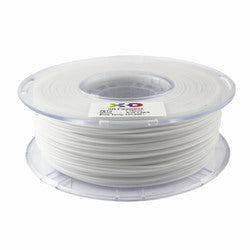If you want to buy PETG filament but have no idea what it is, think of PET plastic bottles. The PETG 3D filament is the sibling of PET with just one component differentiating the two: glycol. This chemical completely changes the composition of PETG, making softer and more flexible. PETG allows the bottle to have an easy-grip waist. Aside from aesthetics, PETG also prevents the undesirable characteristics of PET like its crystallization, brittleness, and haziness during the heat.
However, PETG filament has its own share of drawbacks due to its softer build such as being resistance to autoclaving and increased susceptibility to UV light damage and scratches. Overall, the advantages of PETG 3D filament outweigh the bad when you think of its durability, shock resistance, high heat tolerance, RF sealable, and comfortable grip.
Best Applications for PETG
Aside from water bottles, PETG filament is good for making food containers, mechanical parts, 3D printer parts, protective components, planter pots, and waterproof pieces, among other plastic materials.
Important Things to Know before Printing PETG Filament
PETG 3D filament is not for the weak of heart. It can be difficult for beginners to print with this as it requires specific print settings in order to come out great. Here are things to remember before diving into printing PETG filaments.
- Heated build platform is recommended. For successful prints using PETG 3D filament, you need to have quality heated build platform. While glass bed or blue painter’s tape built in some 3D printers are good enough, a good heated build platform can take the results up a notch. It improves the first layer adhesion, making it easier for the succeeding prints. Heated bed platforms also typically have its own glass surface, making it easier to print directly without the need for additional globs of glue or tape.
- Refine the extruder settings. Although PETG filament has a high heat tolerance, there comes a point where small zits or blobs might appear on your model if the temperature gets too high. It is why it’s important to adjust the extruder options in your software before printing.
- Tweak the retraction settings. Improper retraction settings can lead to stringing, thin hairs that appear in between different surfaces of a PETG filament print. Adjusting the retraction speed and distance can prevent this.
- Turn off the part cooling fan. For the first few print layers of larger prints, it is advisable to disable the fan to avert warping.
Best PETG Filament Print Settings
Print temperature: 220°C – 250°C
It is important to print PETG 3D filament at the right temperature. Blobbing and stringing can happen when the temperature is too high, while delaminating and jamming occur when it is too cold. There is no specific printing temperature as it varies with the brand of the PETG filament you buy.
Print bed temperature: 50°C – 75°C
PETG Filament on Different Print Beds
- Blue painter’s tape: Next to a heated bed platform, a blue painter’s tape is the next best thing to print PETG 3D filament on.
- Glass: It lends a glossy surface to the print due to the smoothness of the glass. However, it requires a heated bed.
- BuildTak: PETG filament also works well with BuildTak printing surfaces. They tend to wear down over time.
PETG filament will give your prints flexibility, durability, and smooth and glossy surface finish. If you want to start printing with PETG filament, find the best PETG filament in Australia in X3D’s wide collection of filaments.

